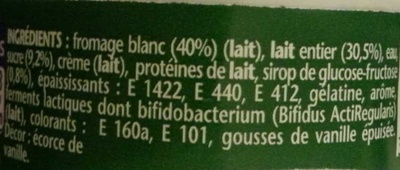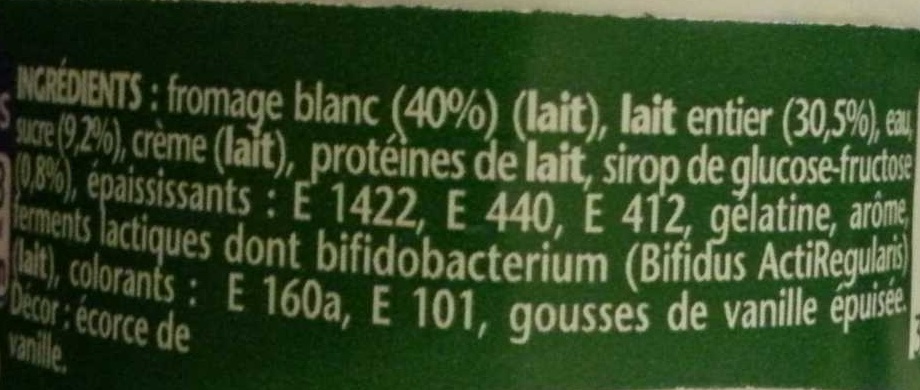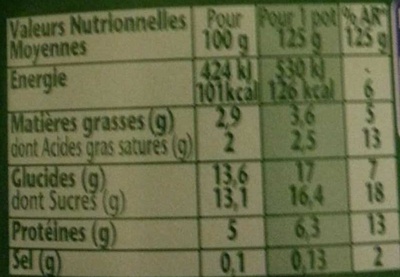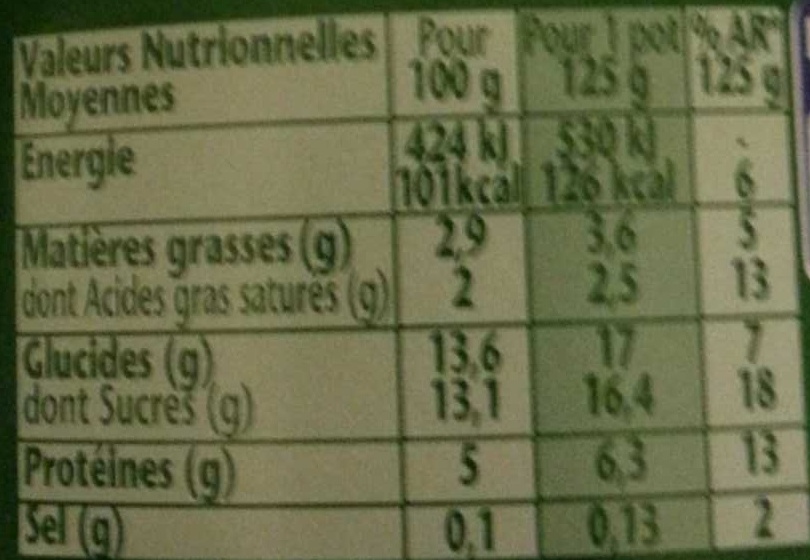Help us make food transparency the norm!
As a non-profit organization, we depend on your donations to continue informing consumers around the world about what they eat.
The food revolution starts with you!
Activia Recette au fromage blanc (2,9 % MG) Saveur Vanille - Danone - 500 g (4 x 125 g)
Activia Recette au fromage blanc (2,9 % MG) Saveur Vanille - Danone - 500 g (4 x 125 g)
This product page is not complete. You can help to complete it by editing it and adding more data from the photos we have, or by taking more photos using the app for Android or iPhone/iPad. Thank you!
×
Barcode: 3033490004224 (EAN / EAN-13)
Common name: Spécialité laitière sucrée aromatisée, au fromage blanc et au bifidus
Quantity: 500 g (4 x 125 g)
Packaging: Plastic, Pot, Fresh, Seal
Categories: Dairies, Fermented foods, Fermented milk products, Desserts, Dairy desserts, Fermented dairy desserts, Flavoured fermented dairy desserts, fr:Fromages blancs, fr:Fromages blancs aromatisés
Labels, certifications, awards:
Green Dot, fr:2, fr:9 % MG, fr:Eco-Emballages
Manufacturing or processing places: Danone Produits Frais France (DPFF) - Route de Savignies - 76220 Ferrières-en-Bray, Seine-Maritime, Haute-Normandie, France
Traceability code: FR 76.260.001 CE - Ferrières-en-Bray (Seine-Maritime, France)
Link to the product page on the official site of the producer: https://www.dan-on.com/fr-fr/retrouver-t...
Stores: Auchan
Countries where sold: France
Matching with your preferences
Health
Ingredients
-
21 ingredients
French: Fromage blanc (40 %) (lait), lait entier (30.5 %), eau, sucre (9.2 %), crème (lait), protéines de lait, sirop de glucose-fructose (0.8 %), épaississants : E1422, E440, E412, gélatine, arôme, ferments lactiques dont bifidobacterium (Bifidus ActiRegularis) (lait), colorants : E160a, E101, gousses de vanille épuisée. Décor : écorce de vanille.Allergens: Milk
Food processing
-
Ultra processed foods
Elements that indicate the product is in the 4 - Ultra processed food and drink products group:
- Additive: E101 - Riboflavin
- Additive: E1422 - Acetylated distarch adipate
- Additive: E160a - Carotene
- Additive: E412 - Guar gum
- Additive: E428 - Gelatine
- Additive: E440 - Pectins
- Ingredient: Colour
- Ingredient: Flavouring
- Ingredient: Glucose
- Ingredient: Milk proteins
- Ingredient: Thickener
Food products are classified into 4 groups according to their degree of processing:
- Unprocessed or minimally processed foods
- Processed culinary ingredients
- Processed foods
- Ultra processed foods
The determination of the group is based on the category of the product and on the ingredients it contains.
Additives
-
E101 - Riboflavin
Riboflavin: Riboflavin, also known as vitamin B2, is a vitamin found in food and used as a dietary supplement. Food sources include eggs, green vegetables, milk and other dairy product, meat, mushrooms, and almonds. Some countries require its addition to grains. As a supplement it is used to prevent and treat riboflavin deficiency and prevent migraines. It may be given by mouth or injection.It is nearly always well tolerated. Normal doses are safe during pregnancy. Riboflavin is in the vitamin B group. It is required by the body for cellular respiration.Riboflavin was discovered in 1920, isolated in 1933, and first made in 1935. It is on the World Health Organization's List of Essential Medicines, the most effective and safe medicines needed in a health system. Riboflavin is available as a generic medication and over the counter. In the United States a month of supplements costs less than 25 USD.Source: Wikipedia
-
E1422 - Acetylated distarch adipate
Acetylated distarch adipate: Acetylated distarch adipate -E1422-, is a starch that is treated with acetic anhydride and adipic acid anhydride to resist high temperatures. It is used in foods as a bulking agent, stabilizer and a thickener. No acceptable daily intake for human consumption has been determined.Source: Wikipedia
-
E160a - Carotene
Carotene: The term carotene -also carotin, from the Latin carota, "carrot"- is used for many related unsaturated hydrocarbon substances having the formula C40Hx, which are synthesized by plants but in general cannot be made by animals -with the exception of some aphids and spider mites which acquired the synthesizing genes from fungi-. Carotenes are photosynthetic pigments important for photosynthesis. Carotenes contain no oxygen atoms. They absorb ultraviolet, violet, and blue light and scatter orange or red light, and -in low concentrations- yellow light. Carotenes are responsible for the orange colour of the carrot, for which this class of chemicals is named, and for the colours of many other fruits, vegetables and fungi -for example, sweet potatoes, chanterelle and orange cantaloupe melon-. Carotenes are also responsible for the orange -but not all of the yellow- colours in dry foliage. They also -in lower concentrations- impart the yellow coloration to milk-fat and butter. Omnivorous animal species which are relatively poor converters of coloured dietary carotenoids to colourless retinoids have yellowed-coloured body fat, as a result of the carotenoid retention from the vegetable portion of their diet. The typical yellow-coloured fat of humans and chickens is a result of fat storage of carotenes from their diets. Carotenes contribute to photosynthesis by transmitting the light energy they absorb to chlorophyll. They also protect plant tissues by helping to absorb the energy from singlet oxygen, an excited form of the oxygen molecule O2 which is formed during photosynthesis. β-Carotene is composed of two retinyl groups, and is broken down in the mucosa of the human small intestine by β-carotene 15‚15'-monooxygenase to retinal, a form of vitamin A. β-Carotene can be stored in the liver and body fat and converted to retinal as needed, thus making it a form of vitamin A for humans and some other mammals. The carotenes α-carotene and γ-carotene, due to their single retinyl group -β-ionone ring-, also have some vitamin A activity -though less than β-carotene-, as does the xanthophyll carotenoid β-cryptoxanthin. All other carotenoids, including lycopene, have no beta-ring and thus no vitamin A activity -although they may have antioxidant activity and thus biological activity in other ways-. Animal species differ greatly in their ability to convert retinyl -beta-ionone- containing carotenoids to retinals. Carnivores in general are poor converters of dietary ionone-containing carotenoids. Pure carnivores such as ferrets lack β-carotene 15‚15'-monooxygenase and cannot convert any carotenoids to retinals at all -resulting in carotenes not being a form of vitamin A for this species-; while cats can convert a trace of β-carotene to retinol, although the amount is totally insufficient for meeting their daily retinol needs.Source: Wikipedia
-
E412 - Guar gum
Guar gum (E412) is a natural food additive derived from guar beans.
This white, odorless powder is valued for its remarkable thickening and stabilizing properties, making it a common ingredient in various food products, including sauces, dressings, and ice creams.
When used in moderation, guar gum is considered safe for consumption, with no known adverse health effects.
-
E440 - Pectins
Pectins (E440) are natural carbohydrates, predominantly found in fruits, that act as gelling agents in the food industry, creating the desirable jelly-like texture in jams, jellies, and marmalades.
Pectins stabilize and thicken various food products, such as desserts, confectioneries, and beverages, ensuring a uniform consistency and quality.
Recognized as safe by various health authorities, pectins have been widely used without notable adverse effects when consumed in typical dietary amounts.
Ingredients analysis
-
May contain palm oil
Ingredients that may contain palm oil: E160a
-
Non-vegan
Non-vegan ingredients: Fromage blanc, Whole milk, Cream, Milk proteins, E428
-
Non-vegetarian
Non-vegetarian ingredients: E428
-
Details of the analysis of the ingredients
fr: Fromage blanc 40%, _lait_ entier 30.5%, eau, sucre 9.2%, crème, protéines de _lait_, sirop de glucose-fructose 0.8%, épaississants (e1422), e440, e412, gélatine, arôme, ferments lactiques dont bifidobacterium (Bifidus ActiRegularis), colorants (e160a), e101, gousses de vanille épuisée, Décor (écorce de vanille)- Fromage blanc -> en:fromage-blanc - vegan: no - vegetarian: maybe - ciqual_food_code: 19501 - percent_min: 40 - percent: 40 - percent_max: 40
- _lait_ entier -> en:whole-milk - vegan: no - vegetarian: yes - ciqual_food_code: 19023 - percent_min: 30.5 - percent: 30.5 - percent_max: 30.5
- eau -> en:water - vegan: yes - vegetarian: yes - ciqual_food_code: 18066 - percent_min: 9.2 - percent_max: 17.9
- sucre -> en:sugar - vegan: yes - vegetarian: yes - ciqual_proxy_food_code: 31016 - percent_min: 9.2 - percent: 9.2 - percent_max: 9.2
- crème -> en:cream - vegan: no - vegetarian: yes - ciqual_food_code: 19402 - percent_min: 0.8 - percent_max: 6.76666666666666
- protéines de _lait_ -> en:milk-proteins - vegan: no - vegetarian: yes - percent_min: 0.8 - percent_max: 4.875
- sirop de glucose-fructose -> en:glucose-fructose-syrup - vegan: yes - vegetarian: yes - ciqual_food_code: 31077 - percent_min: 0.8 - percent: 0.8 - percent_max: 0.8
- épaississants -> en:thickener - percent_min: 0 - percent_max: 0.8
- e1422 -> en:e1422 - vegan: yes - vegetarian: yes - percent_min: 0 - percent_max: 0.8
- e440 -> en:e440a - vegan: yes - vegetarian: yes - percent_min: 0 - percent_max: 0.8
- e412 -> en:e412 - vegan: yes - vegetarian: yes - percent_min: 0 - percent_max: 0.8
- gélatine -> en:e428 - vegan: no - vegetarian: no - percent_min: 0 - percent_max: 0.8
- arôme -> en:flavouring - vegan: maybe - vegetarian: maybe - percent_min: 0 - percent_max: 0.8
- ferments lactiques dont bifidobacterium -> es:bifidobacterias-y-otros-fermentos-lacticos - vegan: maybe - vegetarian: yes - percent_min: 0 - percent_max: 0.8
- Bifidus ActiRegularis -> en:bifidus-actiregularis - vegan: maybe - vegetarian: yes - percent_min: 0 - percent_max: 0.8
- colorants -> en:colour - percent_min: 0 - percent_max: 0.8
- e160a -> en:e160a - vegan: maybe - vegetarian: maybe - from_palm_oil: maybe - percent_min: 0 - percent_max: 0.8
- e101 -> en:e101 - vegan: maybe - vegetarian: yes - percent_min: 0 - percent_max: 0.8
- gousses de vanille épuisée -> en:exhausted-vanilla-pod - vegan: yes - vegetarian: yes - percent_min: 0 - percent_max: 0.8
- Décor -> en:coating - vegan: maybe - vegetarian: maybe - percent_min: 0 - percent_max: 0.8
- écorce de vanille -> en:vanilla-pod - vegan: yes - vegetarian: yes - percent_min: 0 - percent_max: 0.8
Nutrition
-
Good nutritional quality
⚠ ️Warning: the amount of fiber is not specified, their possible positive contribution to the grade could not be taken into account.⚠ ️Warning: the amount of fruits, vegetables and nuts is not specified on the label, it was estimated from the list of ingredients: 0This product is not considered a beverage for the calculation of the Nutri-Score.
Positive points: 3
- Proteins: 3 / 5 (value: 5, rounded value: 5)
- Fiber: 0 / 5 (value: 0, rounded value: 0)
- Fruits, vegetables, nuts, and colza/walnut/olive oils: 0 / 5 (value: 0, rounded value: 0)
Negative points: 4
- Energy: 1 / 10 (value: 424, rounded value: 424)
- Sugars: 2 / 10 (value: 13.1, rounded value: 13.1)
- Saturated fat: 1 / 10 (value: 2, rounded value: 2)
- Sodium: 0 / 10 (value: 40, rounded value: 40)
The points for proteins are counted because the negative points are less than 11.
Nutritional score: (4 - 3)
Nutri-Score:
-
Nutrient levels
-
Fat in low quantity (2.9%)
What you need to know- A high consumption of fat, especially saturated fats, can raise cholesterol, which increases the risk of heart diseases.
Recommendation: Limit the consumption of fat and saturated fat- Choose products with lower fat and saturated fat content.
-
Saturated fat in moderate quantity (2%)
What you need to know- A high consumption of fat, especially saturated fats, can raise cholesterol, which increases the risk of heart diseases.
Recommendation: Limit the consumption of fat and saturated fat- Choose products with lower fat and saturated fat content.
-
Sugars in high quantity (13.1%)
What you need to know- A high consumption of sugar can cause weight gain and tooth decay. It also augments the risk of type 2 diabetes and cardio-vascular diseases.
Recommendation: Limit the consumption of sugar and sugary drinks- Sugary drinks (such as sodas, fruit beverages, and fruit juices and nectars) should be limited as much as possible (no more than 1 glass a day).
- Choose products with lower sugar content and reduce the consumption of products with added sugars.
-
Salt in low quantity (0.1%)
What you need to know- A high consumption of salt (or sodium) can cause raised blood pressure, which can increase the risk of heart disease and stroke.
- Many people who have high blood pressure do not know it, as there are often no symptoms.
- Most people consume too much salt (on average 9 to 12 grams per day), around twice the recommended maximum level of intake.
Recommendation: Limit the consumption of salt and salted food- Reduce the quantity of salt used when cooking, and don't salt again at the table.
- Limit the consumption of salty snacks and choose products with lower salt content.
-
-
Nutrition facts
Nutrition facts As sold
for 100 g / 100 mlAs sold
per serving (125g)Compared to: fr:Fromages blancs aromatisés Energy 424 kj
(101 kcal)530 kj
(127 kcal)- Fat 2.9 g 3.62 g -4% Saturated fat 2 g 2.5 g +1% Carbohydrates 13.6 g 17 g +17% Sugars 13.1 g 16.4 g +20% Fiber ? ? Proteins 5 g 6.25 g -22% Salt 0.1 g 0.125 g +7% Fruits‚ vegetables‚ nuts and rapeseed‚ walnut and olive oils (estimate from ingredients list analysis) 0 % 0 %
Environment
-
Eco-Score B - Low environmental impact
⚠ ️Select a country in order to include the full impact of transportation.The Eco-Score is an experimental score that summarizes the environmental impacts of food products.→ The Eco-Score was initially developped for France and it is being extended to other European countries. The Eco-Score formula is subject to change as it is regularly improved to make it more precise and better suited to each country.Life cycle analysis
-
Average impact of products of the same category: A (Score: 91/100)
Category: Fresh cream cheese, plain, around 3% fat
Category: Fresh cream cheese, plain, around 3% fat
- PEF environmental score: 0.19 (the lower the score, the lower the impact)
- including impact on climate change: 1.84 kg CO2 eq/kg of product
Stage Impact Agriculture
64.0 %Processing
14.6 %Packaging
7.9 %Transportation
7.5 %Distribution
4.7 %Consumption
1.3 %
Bonuses and maluses
-
Missing origins of ingredients information
Malus: -5
⚠ ️ The origins of the ingredients of this product are not indicated.
If they are indicated on the packaging, you can modify the product sheet and add them.
If you are the manufacturer of this product, you can send us the information with our free platform for producers.
-
Packaging with a medium impact
Malus: -11
Shape Material Recycling Impact Seal Plastic High Pot Unknown High ⚠ ️ The information about the packaging of this product is not sufficiently precise (exact shapes and materials of all components of the packaging).⚠ ️ For a more precise calculation of the Eco-Score, you can modify the product page and add them.
If you are the manufacturer of this product, you can send us the information with our free platform for producers.
Eco-Score for this product
-
Impact for this product: B (Score: 75/100)
Product: Activia Recette au fromage blanc (2,9 % MG) Saveur Vanille - Danone - 500 g (4 x 125 g)
Life cycle analysis score: 91
Sum of bonuses and maluses: -16
Final score: 75/100
-
Carbon footprint
-
Equal to driving 1.0 km in a petrol car
184 g CO² per 100g of product
The carbon emission figure comes from ADEME's Agribalyse database, for the category: Fresh cream cheese, plain, around 3% fat (Source: ADEME Agribalyse Database)
Stage Impact Agriculture
70.8 %Processing
7.0 %Packaging
9.8 %Transportation
10.0 %Distribution
1.9 %Consumption
0.4 %
Packaging
-
Packaging with a medium impact
-
Packaging parts
Seal (Plastic)
Pot
-
Packaging materials
Material % Packaging weight Packaging weight per 100 g of product Plastic
-
Transportation
-
Origins of ingredients
Missing origins of ingredients information
⚠ ️ The origins of the ingredients of this product are not indicated.
If they are indicated on the packaging, you can modify the product sheet and add them.
If you are the manufacturer of this product, you can send us the information with our free platform for producers.Add the origins of ingredients for this product Add the origins of ingredients for this product
Report a problem
-
Incomplete or incorrect information?
Category, labels, ingredients, allergens, nutritional information, photos etc.
If the information does not match the information on the packaging, please complete or correct it. Open Food Facts is a collaborative database, and every contribution is useful for all.
Data sources
Product added on by openfoodfacts-contributors
Last edit of product page on by femmenoire.
Product page also edited by desan, jacob80, jeanbono, packbot.











